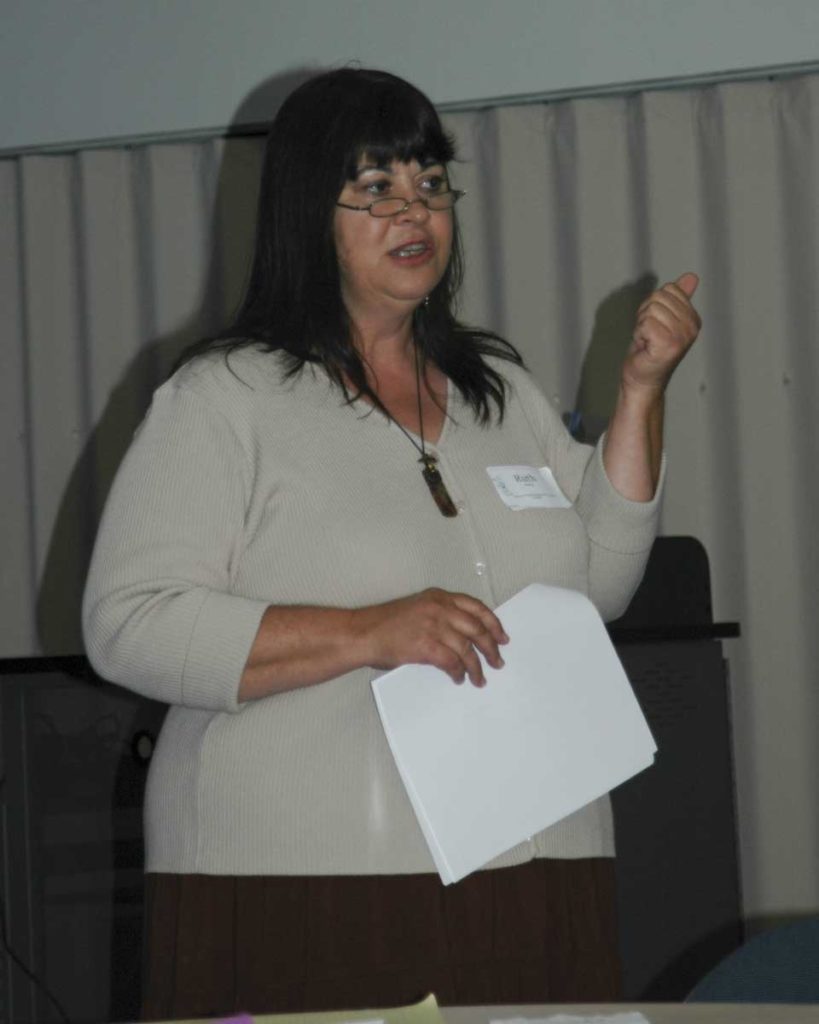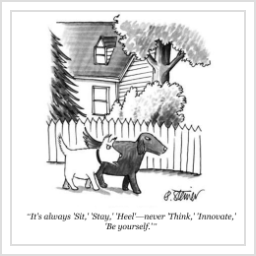Last Friday, Thomas really wanted to go fishing, so we drove up to Rocky Pond outside of Belleville. My friend Nick, who lives there, met us. He’s an expert fisherman. It was cold and windy. Nick caught the only fish.
Category Archives: autoethnography
Creativity – Now is the Time
In the midst of coping with the global pandemic and moving all of our activities online, many people are thinking that they have been completely hamstrung, unable to do their work and unable to function in a way that feels normal.
Someone at the Wakonse Conference on College Teaching(I think it was Gail Ludwig) once said,
Normal is a setting on a clothes dryer.
In other words, there is no such thing as normal. There is only what we are accustomed to. There is only what we prefer or wish for. It is all a matter of perspective.
There are people like myself who have been living a portion of their lives online for some time now. You might call me an early adopter, relatively speaking. Of course, there were early pioneers of digital culture who were working and living digitally for decades before I began exploring these tools. But the mass creation of digital citizens with the advent of modern social media platforms like Facebook came a couple of decades after I began exploring the realm of the online world.
America Online was an online community created by brute force. Millions of AOL disks were sent out, the majority of which became coffee cup coasters and landfill debris. I was learning and exploring before even that major push to bring people together online. My life and work were radically altered and I wanted to tell as many people about it as I could.
I created my very first HTML webpage on a yellow legal pad sitting inside a tent in a soggy Minnesota campground, sometime in the early 1990s. My only reference was a printed copy of Webpages for Dummies. I hand wrote the HTML code that I wanted to use to create a webpage. I don’t recall if that experience predated or came after my Geocities website; both happened around the same time. Geocities was a shared web hosting platform. You coded up your webpages and you could have a free website. The websites generally looked horrible, but the community was wonderful!
The whole site was arranged by interest group. My group was Cape Canaveral. I searched the Geocities archive for the site I built there, but I was not able to find it. I thought perhaps I had written about my time in the Navy, so I searched for “Yokosuka,” the port city in Japan where I was stationed. I didn’t find anything written by me, but I found a fascinating page about the occupation of Yokosuka at the end of WWII. There was some really good stuff on that early Internet community.
I’m telling you about my long history of working and living digitally because we now find ourselves in a situation where these kinds of skills are extremely sought after. Only now, it seems, has the need for these digital communication tools and skills been brought to the forefront of nearly everyone’s consciousness and imagination.
Where have you all been? I have been waiting for you!
I have even made a digital media degree program to teach you what you need to survive in the digital realm. For a long time, it has felt as though my efforts and knowledge have gone largely unrecognized. And a number of those who have shown up have questioned what I have been trying to achieve.
I remember constantly getting comments on my teaching evaluations from students who resented being made to go online to “do risky things and share personal information” or “join an online learning community collaborating with others at a distance.” I remember worrying about what my colleagues thought about such comments. Yes, I did and still do encourage students to share the projects they are working on and to use their own names. I have long believed this fosters a better Internet. Only anonymous people are trolls. However, I understand that everyone is unique and sees things from their own point of view. I don’t force anyone to reveal their identity. I only recommend it as a best practice.
I believe sharing stuff online also encourages students to put their best foot forward and to not simply go through the motions but actually strive to please an audience beyond the “audience of one,” the professor who is grading the assignment. I believe it also opens up the possibility of someone with influence seeing your excellent work and helping you. This has happened to me many times over the years. I would never recommend doing things I am unwilling to do myself.
Austin Kleon wrote a terrific book that explains these principles, Show Your Work. Maybe I should have just written a similar book, I have been telling my students about these things for so long. To me, these principles are self-evident. Never before in human history has it been so easy to be discovered, to have your work seen, to be recognized. You might be asking, “If it is so easy, why haven’t you done it yet.” I’m just not that great at explaining, summarizing and promotion. I suppose it is something I should work on.
But now we have been forced into hiding, but we are venturing out – online. People are doing live broadcasts and creating digital content who have never ever done such things before because there was no demand or need for it like there is right now. I have been getting such a kick out of working with these enthusiastic new learners. They are constantly looking at me with awe and wonder, “you know how to do that? That skill is amazing!” they say. And I just shrug and smile and say, well I’ve been burning my own CDs for the past 25 years.
If you are not trying out some new things these days. If you are not experimenting, stretching and increasing your skills. If you are not documenting your day to day experiences in all of this chaos, you are missing out.
Now is the time for creativity.
Thomas’ new chickens
He is all grown up, but he’s still Farm Boy Tom!
Fun & Easy Art Lessons With Lynda Barry
These simple drawing lessons from Lynda Barry will be fun for the whole family!
K-State Open House circa 2005
I found an unexpected video clip recently. This is of K-State professors Troy & Kathy Brockway’s kids at the open house on the Kansas State University Polytechnic Campus sometime around 2005 or so. The older girls are working on a Betty Edwards drawing activity, and the youngest Brockway is just being cute. We also can see a glimpse of Professor Troy Harding talking with someone in the hallway.
Emily Learns to Write
Digging into the old video footage this week and found this gem of my daughter Emily when she was about three and a half years old. She was just learning to write her name, and she wrote it on walls all over the house. She was a little chatterbox back then.
Teach On Conference – 2006
In August of 2006, K-State Polytechnic (then called K-State Salina) hosted an inter-institutional day of professional development for faculty from multiple institutions of higher learning in the region. The two main collaborating partners were Cloud County CC and K-State Salina.
 It was at this conference that I first met Ruth Moritz who was then working at Barton County. Ruth eventually found her way to teach on the K-State campus in Salina. We became good friends and I was deeply saddened when she left to teach for Kansas Wesleyan.
It was at this conference that I first met Ruth Moritz who was then working at Barton County. Ruth eventually found her way to teach on the K-State campus in Salina. We became good friends and I was deeply saddened when she left to teach for Kansas Wesleyan.
A Tale of Recovered Digital Media
 Several years ago a large external hard drive I had been using for home and work for about six years died on me. Because it was so large and expensive at the time, I had no backup. I lost most of my saved work from six years of my life.
Several years ago a large external hard drive I had been using for home and work for about six years died on me. Because it was so large and expensive at the time, I had no backup. I lost most of my saved work from six years of my life.
When I finally realized that I wasn’t going to see that data again, it literally felt like being kicked in the stomach. Enormous pressure built up in my chest, my heart was racing, I couldn’t breathe and I imagined that people who experience a house fire losing all of their precious family photos must feel precisely the same way because that is what had happened to me.
“You idiot!” I thought. You call yourself a computer professional? You, of all people, know better than to rely on a single drive with no backup. Now you have lost all of the kids’ baby pictures, movies, and sound recordings, not to mention all of that stuff you created for work.
But this was a terabyte hard drive, back when most people did not have so much storage, and it cost over $500. I simply couldn’t afford to purchase another one to make backups (although I certainly could have used another media like CDs and DVDs to make backups of the favorite items). Of course, making print photos was still a thing when the kids were small and we have some of those too, but many, many of our family memories were inaccessible and presumably lost forever.
I looked into a data-recovery service. I was in luck, they told me. As a member of the staff of Kansas State University, I was eligible for a discount because my employer was a partner to that service. I was quoted the reduced price to recover one terabyte of data of approximately $1800 – $2000! So if I thought $500 for a backup drive was bad, try paying for the data-recovery rate!
I seriously contemplated paying for data recovery. I couldn’t bear the thought of losing all of those memories. The company sent me a special padded shipping box for my external drive. When the shipping box arrived, it was too small to hold my drive. It was meant to hold a (now) standard sized smaller external hard drive, but my terabyte drive was actually a Seagate enclosure that held two full-sized internal hard drives along with RAID electronics that make the two drives appear as a single drive. It was far too big to be shipped in the provided box.
So I hesitated, put off the data recovery idea, put my broken drive into storage in the closet, and tried to forget about it.
Every once in a while, I would pull that terabyte drive back out and test it just to be sure I wasn’t mistaken. Nope. Every time, it still was unreadable by any computer or operating system I attached it to. I even went so far as to remove the internal HDD drives from the enclosure and attempted to read them directly with a USB device that could read and power these devices. Still nope.
This process went on for nearly seven years. The last files that I saved to the failed drive were created in February of 2012. As I began working seriously on my doctorate, I purchased not one, but two external drives that are 2TB in size, and I was very diligent about mirroring one on to the second drive and keeping one at work and the other at home. I had no intention of ever letting a failed hard drive get me again.
Of course, over that time, cloud storage has made its appearance and is taking over the way we save data. I have moved away from using external drives altogether and mostly rely on the cloud. It actually is quite nice since I can access it from home or at work. But I still keep my own copies of personal files like photos and home movies.
Then, last week, something happened. I was doing some cleaning at home and came across that failed hard drive. There it sat, a symbol of my incompetence, mocking me once again. I don’t know why, but I’m going to pull it out and try again. I have a new Macbook I didn’t have before. Maybe my luck will turn.
So I hooked it all up, and the lights came on and… still nobody home. Sigh. Well it was worth a shot.
Hmm, here is something I don’t remember seeing. There is a tiny “reset” button on the enclosure. I wonder what would happen if I pushed that? Now I have seen these tiny little “reset” buttons before, usually on something like a router or other embedded computing device. You have to get a pen or paperclip to even push the button it is so small.
I pushed “reset” and guess what happened? Nothing. A loud cooling fan noise, just like every other time the drive powered up, some blue LED lights, and nothing. No readable drive.
But after a couple of minutes, incredibly, unthinkably, that darned Seagate drive became readable again! Well, I don’t dare turn this thing off again. So I grabbed one of my other drives that had plenty of space and started copying things, beginning with the family photos, then the work documents, then the home movies.
Copy, copy, copy. I spent most of last weekend copying things to the backup drive. Soon, my daughter noticed what I was doing.
She – Dad, isn’t that the drive that quit working you were so upset about?
Me- Yep. It started working again.
She- So what is on it?
So we started poking around in the photos to see what was there. A big smile came across her face as she saw all of her classmates in pre-school. She’s a Junior in high school now. We saw photos of swimming lessons, wheat harvest, Watermelon Festival, birthdays, and family gatherings of all sorts,
Having gone through that difficult emotional loss, and just recently finding the lost thing again, I feel just like those people in the Bible who lost a sheep and a coin (Luke 15:1-10).
It has been a good week. Rejoice with me, for I have found my lost data!

